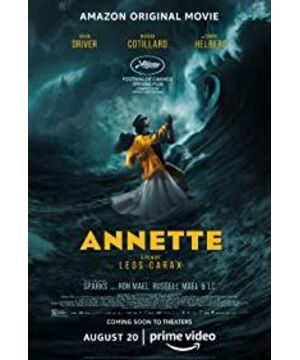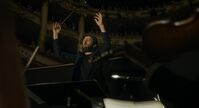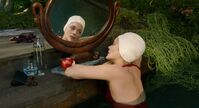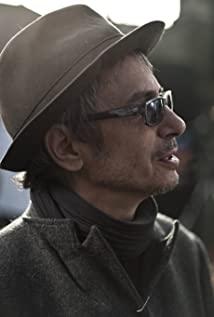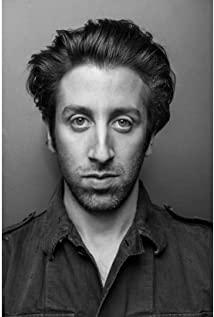Preamble: I'm sorry, I'm Kabuki, the full text is 4500 words, and it takes about 17 minutes to read. A detailed interpretation of "Annette" starting with the credits list!
Text: Z1
Edit: oXo
The Phantom of Mutual Life in the Weird Crimson Page
Karax, which emerged in the 1980s, left traces of the phantoms of its predecessors at the beginning of its fame. He turned to director creation after writing as a reviewer in "Cinebooks" and is regarded as "Godard's natural heir" and "post-new wave representative". Although Karax's works have been extremely low-yield, the amazing thing is that all of his works have been overturned and shocked.
The new work "Annette", which has been dormant for nine years, has the label of Karnofsky as always. Under the strong experimental color and avant-garde spirit, he always constructs the peculiar image time and space of his works with broken but rigorous narratives and subjective personalized editing, leading the audience to invade the sensible and unfamiliar through various detached and reflexive means. the inner world.
In a rich and unique film language, Karax writes spiritual autobiographical self-loneliness and cruel love. The film begins with the provocative and unreasonable demands of the audience at the opening of the commercial prologue CG, and then tells the eye-catching love of a group of star partners. After the male and the stage's interpretation are distorted, the cruel love is promoted to killing, and there is no love to complain about. The daughter eventually dragged back the soul to rebel against love.
Since the beginning of "Sacred Car Dealer", the interpretation of Karax has become a kaleidoscopic baroque labyrinth. In the limited space of layers, he has accumulated infinite wormholes in which the meaning of the text can be delayed in the chaos of images. The same is true for Annette, which is full of bizarre forms and contents in the new work.
Since it is still necessary to tie the bell to untie the bell, Karax left a question mark for the maze at the end of the song and dance parade of Easter eggs. The flowing subtitle red page has written a thank you list. The thank list itself forms a new text outside the body, and the two have new interactive attributes in the epilogue.
The concept of "intertextuality" first came from the French theorist Kristeva. Combining Saussure's structural linguistics and Bakhtin's polyphonic theory, she believes that "signifiers do not point to things outside the symbolic system, but point to other signifiers in various combinations".
The text Kristeva said is a text in a broad sense. In addition to language and writing, the external world also constitutes a social text that is different from language and writing. Naturally, the "intertextuality" is not just a literary text. The cross-reference and mapping between various text systems includes the interweaving of various heterogeneous text systems. The simple metaphor is a phantom, which mirrors the text itself.
The meaning of a text does not depend on the author. The postmodern "author's death" makes the text obtain its own meaning through the web formed by other texts. The passing of the author gives readers unprecedented freedom of interpretation. The text is no longer a closed system with exact meaning, but a "generative text" that is always in interactive relationship with other texts.
According to the theory of "intertextuality", we will explore some parts in this acknowledgement, and intend to re-examine Karax's "Annette" in a broader network, in order to find the phantom that exists outside the text—— "Another Karax". 
llen Poe - creepy undertone
The importance of Edgar Allan Poe at the top of the credits list is self-evident and can even be said to be an important source of the dark stylization of the movie Annette. Edgar Allan Poe was born in Boston in January 1809 and lived only 40 years in his short life, but he created many great novels, mostly about detectives, goths, revenge, death, even modern ones Readers can still be moved by the eerie atmosphere of death he describes, and his works have a unique charm in the history of American literature.
Poe's murderer and Annette's murderer Henry have very similar behavior patterns when they appear as the narrator during the murder. As the murderer, the narrator "I" tries to claim that he has a normal mind, and subjectively exaggerates the logical motive for killing that "I" has not been clearly deduced, and more of it exists in an irrational character state.
The protagonist in Edgar Allan Poe's novel "William Wilson" is a typical irrational state. The narrator "I" is a divided subject, and the shadow William is actually another "I". "I" kills Shadow William, and what "I" kills is actually another self.
The construction of such a split personality is not difficult to find clues for Henry and An Zhong in "Annette". The film uses a large number of mirrors, glass, etc. as props for repeated use in cutscenes and major scenes. 6 times, while Henry faced as many as 7 times. The mirror, as an object outside the character, reflects the image of the character's main body, and at the same time, it has reshaped the split nature of the character's main body in front of the audience in a deep unconscious state.
In addition to the mirror reflection that divides the subject into two parts, the conscious and the unconscious, the visual modeling in the film is also the construction of the stage. The viewing relationship between the actor and the audience is the difference between the mirror and the gaze. The era of Poe's life naturally eliminated Freud's "personality structure theory" and Sartre's and Lacan's "gaze" theories, but in Poe's role, he felt that self-gaze and self-gaze were presented in a nuanced way. The pressure of self-splitting, naturally, Annette seems to want such a mysterious self-awareness that is divorced from literary theory.
It is such a mysterious self-consciousness that is divorced from literary and artistic theory.  One of the manifestations of irrational "abnormal" is the murder without a motive, and the murderer is the narrator's beloved. In Poe's other short story "Black Cat", the murderer and The relationship between the victims is the husband and wife relationship in "Annette".
The killer of "Black Cat" also blamed alcoholism for his brutality. At the same time, the black cat is demonized and described as, "all black cats are dressed as witches", "it is the black cat that makes "me" irrational and kills his wife." And in "Annette" is demonized The carrier is Annette. Annette's image is dissolved in Henry's memory experience as a joke prop, a nightmare, a marriage puppet. Annette has evolved into a carrier, and it is also the only excuse for Henry's psychological self-escape after irrational killing.
Margueritte - Surreal Vision System System
Surrealist painters are keen to believe that the combination of fantasy and reality is the true and absolute objectivity of the absolute concept. The painter focuses on depicting the subjective spiritual world. This is a process of thinking that confronts oneself and the world. It concretizes the invisible, mixed and complicated subconsciousness, and moves the dream that is contrary to real life into the picture, thereby causing visual senses. shock.
And Margaret mentioned in the list of acknowledgements is different from other surrealist artists who pursue skills and styles, but use his seemingly uncomplicated skills to concentrate on depicting the appearance of objects, and the content he creates is completely It breaks our daily life, using different combinations of various image symbols, such as reorganization and variation, appropriation, contrast mosaic, double image and so on.
The visual style of "Annette" comes from this, and there are a lot of recombination images in the dream of Ann's journey to other places. Under this surreal stylized visual design, the space will make us produce an absurd, even an incredible effect. Displacement and reconstruction can make our original familiar pictures feel unfamiliar, challenge the viewer's visual expectations and experience conventions, and thus arouse people's surprise, thinking and perception.
As for Karax as a manual director, the visual elements will always be dismantled and divided into obsessive stalks in the history of film, such as French Impressionist films: Epstein's Ghost and Phantom, Abel Gance's superimposed creation, Louis Deluc's wood labyrinth, Jean Renoir's farce stage. At the time when the two genres are similar and ambiguous, all explanations are possible, but whether the origin is a surrealist painter or an impressionist film is the "Rashomon" of the original film.
Sondheim - The Musical! The Stage Invades Reality
In addition to suspense, the sub-genre of "Annette" is naturally musical. At the beginning, the genre of musicals combined dance, drama, music and other art forms, and adopted the film mode in content narrative, and most of these films were concentrated in Hollywood musicals. The great success of musicals is inseparable from the use of its musical elements. The narrative that fits the musical elements is combined with the film itself to create new dreams.
One such person on the credits list who has made outstanding contributions to musical theatre is Sondheim. As one of the most influential creators of contemporary musicals, he has won a lot of drama awards at the American Music Awards, and is hailed as "the most important and well-known figure in American musicals". As a stage play, a musical has all the characteristics of a narrative art like a movie. In addition to expressing emotions, it also plays a role in explaining the dramatic conflict, the background of the characters, and playing a role in the development of the plot. One of Sondheim's important creative ideas in the creation of musicals is the idea of "subtext". "The aria, like the dialogue, must have subtext."
From the perspective of the lyricist, the deep meaning beyond the surface meaning must be designed under the lyrics of a musical, and the deep meaning needs to form a specific relationship with the surface meaning, which will be determined by the timely narrative situation.
As an important plot point of the story, the musical in "Annette" is naturally closely related to it, and all the lyrics and the use of the lyrics behind it are all metaphors for the process of text narration. It is common for the lines to indicate the promotion of the plot of the film, but it is not difficult to know that the musical plays an important narrative structure and is intertwined with the Baroque complex and scattered in the structure of the film.
Regarding the tragic fate of Ann's individual character, the questioning in the opera excerpt from the Lost Forest has been metaphorical: "where is the moon?", "where is the starlight?", "Afraid, don't know why ". As the singing reaches a climax in the scene, the meaning of the stage has already invaded the real forest beyond a square inch, and the tragic emotion superimposed on the singing voice lies in the hesitation of the marriage siege and infinitely amplified in the stage dimension.
The difference between the empowerment of opera lyrics and the high and low status of movie characters, in Sondheim's explanation, can only be handled in this way, "allowing the actors to have the content to perform, and the actors will stay on the stage with the singers (and Not an actor) level, and there is not enough psychological content to support the inner motivation and action line that the performance must have, and the setting of subtext can realize the unity of the lyrics and the dramatic situation, that is, the theater of the lyrics.”
The theatricalization of the concept here is the real theater space separated from the film space, and Karax stitches the two in the video. The driven stage invades the film space.
In terms of film language, Karax invades the reality of the film by means of musicals to provoke the viewers. Just as Adam, played by Henry, amplifies the exaggerated performance logic on the stage, the screen should be regarded as the stage. But it's not just about seeking the reflexivity of the medium. From the perspective of behavior logic, Henry's provocative behavior itself still has a narrative function: "First she dies and dies, dies, dies; And then, she bows and bows and bows" Yes On the stage, his wife's remarks imply that the fate of homicide is clearly revealed, and at the same time, it is the tension that accumulates his tragic fate in the future.
The actor does not explain himself apart from the role and the situation, but subtext in the aria requires the audience to intervene. The audience must read the character's heart through experiential imagination and thinking, rather than hear the character's heart. This will mean introducing more rational elements into the musical experience as well as the film experience. This is also Sondheim's claim.
King Vidor - the core of script value
Kim Widow is the only film director on the credits list, and his directorial career spanned 67 years, from the silent period of 1913 until the 1980s, and is the Guinness World Record holder for the longest directorial career. Born in Hungary, he is an alternative director in Golden Hollywood, and the eternal theme of Victor's works is the struggle between the individual and fate, the harsh natural environment or social environment. The same thing is that nested in Annette is the struggle between the star (the individual) and the audience (the environment).
In "Annette", the second creation at the end of "The Masses", one of Jin Weiduo's representative works, appeared as a visual spectacle of the film. Tracing the source, it is not difficult to find the inextricable connection between "The Mass" and "Annette". The masses in "The Masses" symbolize the double pressure of the outside and the inside, the ordinary faces of all living beings and the life under them; Annette in "Annette" is the incarnation of the two-in-one imprisonment of the body and the soul, and the masses The eye-catching unique mask and the mischievous love in it.
In addition to being both thematically valuable and progressive, Karax returns to what was traditional in the studios of Victor's era: the linear time of American cinema and the Hollywood-style superstar.
Based on these two creed-like paradigms of American movies, it is impossible for his protagonist to re-select Lawang. Just like Oscar in "Holy Car", he completes the transformation of his "personal mask" in a visual way. A transformation is the creation of an abstract subject, and each abstract subject presents us with its own inner dimension, which is beyond the finite shell in the infinite overlapping universe. Therefore, the latter actor must be a Hollywood actor like Adam, and Karax wants to fall into the tragic abyss of the ending of Kim Victor's "Crowd" in the dream-making dimension of the DreamWorks Hollywood star system.
It is not easy to make a truly accurate and comprehensive explanation of Karax, because Karax's films are always out of various conventional conventions, but it is not difficult to find the author's romantic origin from the red pages of thanks.
What he's done from "Holy Car Dealer" to "Annette" seems to be breaking the screen all the time. Here, we may need to rethink the question posed by Bazin, "What is a movie?" Follow the image to gradually progress towards reality, and draw a new asymptote for reality by the powerful gravitational force of the image itself.
In the more than 40 years of gradual exploration in the film, Karax has only created seven feature films. This year, after the surprise of "Annette", Karax will enter a long period of dormancy. But it is not difficult to speculate on the unfinished road of Karax. His films can still be expected to expand infinitely to the boundary of pure noumenon. It is certain that time cannot erase his pioneering background, because the screen is his eternal singularity .
View more about Annette reviews


